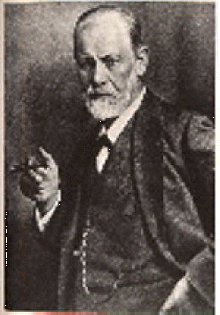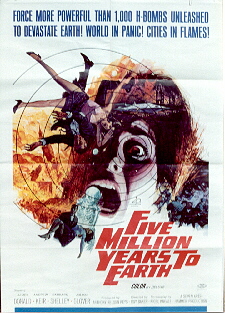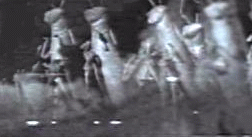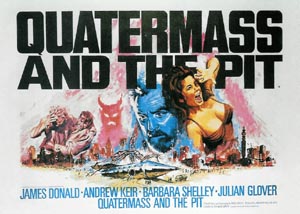January 15, 2005
Human history begins to make sense, but it is no longer human


So many k-punk lines intersect in the passage I've reproduced below from Greil Marcus' Lipstick Traces.
For me, it's the best section of the book - the one which breaks out of the official counter-history (which in any case was even then, in 1989, not so secret) of the Dadaist, Lettrist and Situationist incursion into Pop via punk.
Instead, it produces-discovers a whole other micronarrative web connecting punk, the Freud of Moses and Monotheism and pulp SF. Anarchy in the UK as the realized death drive, as, that is to say, the revenge of the Real upon the reality principle....
As ever a modernist stranded in postmodernity, all time-lines cut and reversed, I hadn't seen Quatermass and the Pit when I read Lipstick Traces in 1989. But Marcus' writing on it triggered flashes of artificial memory because, although I hadn't yet seen Quatermass and the Pit, I had, as you can hardly fail to know, seen Dr Who, which, especially in the Pertwee era, remixed Kneale's hypernaturalist premiss (demons as aliens, the aparently supernatural as the not yet understood scientific) many times.
I read Marcus' book as I laboured under a delusion in a temp factory job (yes, you can imagine how humiliatingly painful my pathetic attempt to function in that world of Real Men was), the downpressing weight of the Real World beginning to hit me in the first few months after graduating.
Of course, the passages on the poverty of everyday life, on the Situationist refusal of work, on punk's demanding of the impossible, the sense that we can't, we shouldn't live like this any more, struck a special chord then. There was I, doing cheap labour in someone else's misery before going onto 'something better' - although that 'something better' turned out to be, in the first instance, an attempt at an MA that ended in my first breakdown, followed by years of unemployment, dead end courses and micro-jobs - temporarily incarcerated with those for whom this was It, working life a forty year sentence of noise, dirt and tedium. (Though not, for them, in that factory; it closed a few years later). And, at that time, as the last of the Seventies Dream faded, I was required to hope for a job in Unilever or something. The memory of those graduate job brochures still fill me with a shivering existential horror: twenty-three year old kids talking about 'the opportunity for early responsibilidy', laughable corporate zombies being held up as some kind of ideal.
I never realised/ the lengths I'd have to go
Everything seemed over, not only for me, but for the whole culture.
Still living at home. Very few friends, none of them women. Those friends themselves locked into temp job misery, like me not having the will to pursue the career ambitions which are the goal of those who have lost any real ambition, or never had it in the first place.
The Marcus book could not but read elegiacally then. I guess that dreams always end. A series of postcards from lost futures, souvenir wreckage from worlds that could have been.
At the same time, it also operated as a storehouse of counter-cultural provisions, a Dreaming kit that, along with Lipstick Traces, Simon and David Stubbs in Melody Maker, the Wire, Vague, would sustain me through the desolate virtual nuclear winter at the fag end of the Cold War and the beginning of the End of History. It wasn't music criticism; like the Pop it described, this discourse was always about more than music: sound was only the vehicle for a raging against the mean inevitabilities and banalizing commonsense of the then smugly dominant reality principle.
And the shoots and spoors of a liveable future, then heartbreakingly far off (only another fifteen years Mark), were already there in those three or four pages by Marcus. A future in which my Seventies childhood would splice with my yet-to-be Junglized nineties dancing body, and with my yet-to-be cyberpunked theory-fiction mind.
Any way, here's Greil:
'I can compare the sensation this performance [the Sex Pistols' last, at San Francisco Winterland in 1978] produced only to Five Million Years to Earth, a film made in England in 1967 under the title Quatermass and the Pit.
The time and place is Swinging London, where the reconstruction of a subway station has revealed a large, oblong, metal object: a spaceship, as any moviegoer could tell the cops and bureaucrats who can’t. Near the object are the fossilized remains of apemen; within it are the perfectly preserved corpses of human-sized insects. The scientist Quatermass is called in.

Putting the pieces together, he determines that, five million years before, Martians—the insects—faced with the extinction of life on their own planet, sent a small band of scientists to earth. Their goal is to implant the Martian essence in an alien life form (the gimmick is a nice anticipation of the theory of the selfish gene): to find a home for the soul of the Martian race.
The Martians, Quatermass slowly learns, were by nature genocidal: the death of their planet is their own work. Indeed it is their masterpiece, and so to maintain themselves on earth they must destroy it. The Martian scientists select the most promising earth creatures—australopithecines, which emerged perhaps eight million years ago, and which most paleoanthropologists consider directly ancestral to our own genus—and, through genetic surgery, set a small group on the road to planetary dominance. Endowed with the Martian traits of cognition and bloodlust (the latter notion, in 1967, a nod to the fashionable human-origin theories of Robert Ardrey), the chosen australopithecines follow their coded path to Homo sapiens and inherit the earth. Once the new species has achieved the technology necessary to dominate nature, destiny will be manifested in its destruction.

But the graft is not perfect; the contradiction between earth and Martian genes is never fully absorbed. Though there is no consciousness of the intervention, there is a phylogenetic memory. Freud believed that modern people in some fashion remember, as actual events, the parricides he thought established human society, and unconsciously preserve that memory in otherwise inexplicably persistent myths and rituals; in Moses and Monotheism he argued that, hundreds of years after the fact, the Israelites carried a memory of their forebears’ murder of a first Moses, even though in oral and written traditions the event was completely suppressed. In Five Milliion Years to Earth the argument is that modern people remember step-parents who, with infinite patience, set out to kill their progeny—and the idea explains why, with their all-powerful science, the Martians did not simply wipe out life on earth as they found it. They meant to perpetuate themselves on earth by making its history—by coding its end in its beginning. A passion for prophecy, it seems, is also a Martian trait: they loved drama as much as death.

For Quatermass, all sorts of phenomena that as a scientist he has dismissed as relics of an irrational past take on a new meaning. Poring through books on ritual and myth, he begins to understand that along with its domination of nature, its march toward mastery and abundance, the new species has produced irreducible images of a primordial displacement. They are attempts to cast the alien out; to abstract the im planted traits from the body, to reify them into demonism. But there is a contradiction here too: it is only the alien intelligence that permits the species to engage in a process as complex as reification—a sort of fetishization of alienation, where human properties are transferred to things that human beings have themselves produced, things that then operate autonomously, finally turning human beings into things—and reification cuts a two-way street. Once expelled, once removed into a representation of the demonic, the alien presence casts a spell. Quatermass discovers that not only did the Martians put their name on the site of the subway station where their remains were found (frantic research reveals that its address, “Hobb's Lane,” once meant “Devil’s Haunt”), thus making it, in medieval times, a cursed place, they have, in the shape of the parthuman, part-horned-animal figure of “The Sorcerer,” inscribed their image on the wall of the Cro-Magnon sanctuary of Trois Frères, thus making it, in paleolithic times, a place of worship. ‘The Sorcerer” echoes across fifteen thousand years into an otherwise inexplicable Christian prayer: “The Lord is in this place, how dreadful is this place.” Human history begins to make sense, but it is no longer human.

The disturbance in the subway station calls up the dormant Martian presence. The spaceship begins to vibrate, and the energy released by the vibrations creates a vacuum. The vacuum sucks up sleeping genes, which create a repulsive, beckoning image: a glowing, horned devil, overshadowing London, the Martian Antichrist.
Across five million years, genetic drift is not uniform. By the twentieth century, some people are coded for destruction; some carry only a few broken alien messages. Some respond to the Martian image; some do not. For those who do, the ancient codes become language, and memories of the original Martian genocide course to the surface. For those who do not respond, language dissolves. Humanity is split into two species; there is anarchy in London. Men and women surge through the streets smashing all those they recognize as alien: all who carry less of the Martian essence than they do. The Martian image turns red. Hobbes’s state of nature was “the war of all against all”; this is it, and it is lurid beyond belief.

More human than Martian, Quatermass lives to see the demonic image vanquished and the Martian genes put back to sleep—but not before a comrade, more human than Quatermass, who can stand to gaze into the face of the image as Quatermass cannot, has been exploded in the attack. The image is pure phylogenetic energy; guiding a steel crane straight into it, Quatermass’ comrade negates the image with mass—a neat Einsteinian twist.
Quatermass’ assistant, more Martian than he, returns to his side as if awakened from a dream; minutes before, she was squeezing blood out of his neck. In a long, silent shot, the movie ends—and because there is no freeze frame, no auto-matic irony, the movie doesn’t seem to end at all. Quatermass and his assistant are seen in the wreckage of London; he leans on a ruined wall. Everything he has seen is in his eyes, and he is trying to forget what he has seen, but the shot—it goes on and on—doesn’t last long enough for his assistant’s eyes to focus.
Now it is plain that Five Million Years to Earth is a 1960s version of 1950s atomic-bomb-mutation films; an exculpatory allegory of Nazism and the Blitz; a quick and easy update of the gnostic heresy in which the world is split between equally empowered Good and Evil gods; a bid to make fast money off whatever dislocations might be circulating in modern society at any given time. It doesn’t play like that. It is progressively horrifying—especially at 2 A.M., when it is most readily seen on television; when, as Nietzsche wrote, “man permits himself to be lied to . . . when he dreams, and his moral sense never even tries to prevent this”; when there is no one with whom one might dominate the film. Quatermass’ victory is the victory of rational certainty over irrational doubt; the doubt in his face at the end is not doubt that he has won, but doubt that he wanted to. Perhaps it is no accident that, on occasion, the Late Show has cut the last twenty minutes: cut the anarchy, offering only the mystery, its formal solution, and then the film’s last shot, which no longer carries any meaning.'
Previous k-punk Quatermass postings:
Nonorganic Memory
Lay! Lay! Lay!
